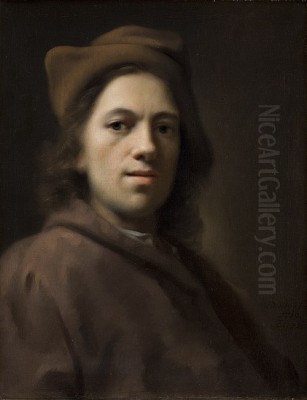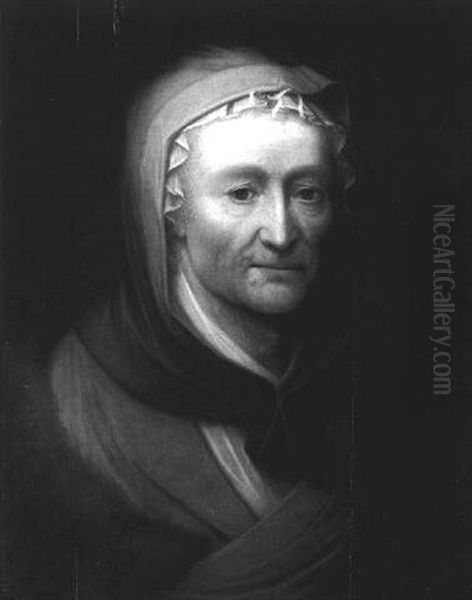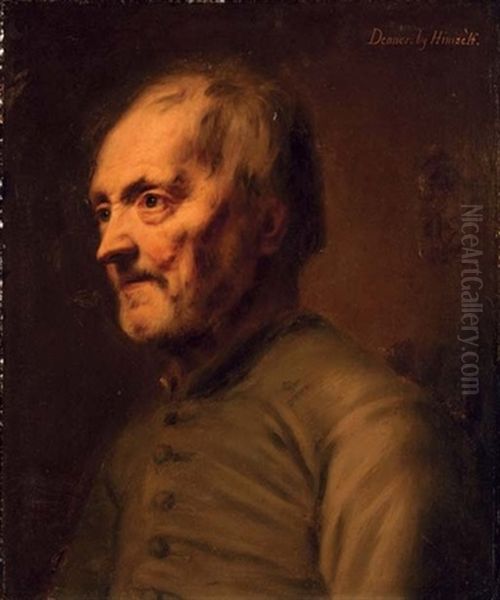An Introduction to the Artist

Balthazar Denner stands as a unique figure in the landscape of 18th-century European art. A German painter active primarily during the first half of the century, he achieved remarkable international fame for his distinctive approach to portraiture. Born in the bustling port city of Hamburg, Denner carved a niche for himself through an almost obsessive dedication to detail, rendering human features with a microscopic precision that astonished his contemporaries and continues to fascinate viewers today. His work, primarily consisting of portraits, often focused on the heads or half-lengths of his subjects, capturing every nuance of skin texture, hair, and age.
Denner's meticulous technique earned him commissions from the highest echelons of European society, including royalty and nobility across Germany, Denmark, England, the Netherlands, and even the Russian Empire. While his style was sometimes criticized for its perceived lack of emotional depth or "spirit," its sheer technical brilliance secured his reputation as one of the most sought-after and highly paid portraitists of his time. His life and work offer a compelling glimpse into the artistic tastes and patronage networks of the late Baroque and early Rococo periods.
Early Life and Artistic Formation
Balthazar Denner was born on November 15, 1685, in Hamburg, Germany. His father, Jakob Denner, was a respected Mennonite preacher, suggesting a background rooted in a religious community often known for its sobriety and emphasis on craft. This upbringing might have subtly influenced the younger Denner's disciplined and painstaking approach to his art. Hamburg, a major center of trade and culture, would have provided a stimulating environment for a budding artist.
His initial artistic training took place in nearby Altona, then under Danish rule, where he likely studied with a local painter, possibly Franz van Amama. Seeking further instruction, he later moved to Danzig (modern-day Gdańsk, Poland), another important Baltic Sea port city with its own artistic traditions. This period likely exposed him to various Northern European artistic currents.

Denner's formal artistic education culminated with studies at the prestigious Prussian Academy of Arts (Akademie der Künste) in Berlin around 1709. Founded in 1696, the Academy was a key institution in promoting artistic standards and training in the German-speaking lands. Studying there provided Denner with a solid grounding in academic principles, even though his subsequent style would develop in a highly personal and specialized direction. This formal training, combined with his earlier experiences, laid the foundation for his professional career.
The Emergence of a Unique Style: Finmalerei Perfected
Denner's artistic signature became his extraordinary commitment to detail, a style often referred to using the German term Finmalerei (fine painting). He pushed the boundaries of realistic representation to an extreme, particularly in his rendering of human skin. His paintings captured not just wrinkles and lines, but also the subtle pores, the finest, almost invisible hairs (lanugo), and the complex interplay of light on varied textures. This level of detail was often achieved through the reported use of magnifying glasses and extremely fine brushes.
His focus was typically on the face, creating an intense, almost hyperrealistic effect. Contemporaries marveled at the lifelike quality of his portraits, which seemed to replicate reality with uncanny precision. This meticulousness was particularly evident in his depictions of elderly subjects, whose aged skin provided a complex canvas for his skills. The intricate network of wrinkles, the texture of weathered skin, and the subtle variations in coloration were rendered with astonishing fidelity.
This pursuit of minute detail led to nicknames like "Poren-Denner" (Pore-Denner). While intended descriptively, such names also hinted at the potential criticism that his focus was perhaps too microscopic, potentially sacrificing a broader sense of character for surface accuracy. Nonetheless, it was this very quality that captivated patrons and set him apart from other portraitists of his era.
Travels and Illustrious Patronage
Denner's burgeoning reputation soon attracted attention beyond Hamburg. Around 1712, he received his first significant commissions from the court of Duke Christian August of Schleswig-Holstein-Gottorp. This marked the beginning of a career characterized by extensive travel and service to numerous European courts. He spent time at various German principalities, including Hanover, Wolfenbüttel, Blankenburg, and Dresden, painting members of the ruling families.
His fame spread internationally. He was invited to the Danish court in Copenhagen around 1721, where he painted King Frederick IV and members of the royal family. His work was highly valued; one commission from the Danish king reportedly earned him the substantial sum of 5,000 florins. This period cemented his status as a painter favored by royalty.

Between approximately 1721 and 1728, Denner spent considerable time in London. England offered a lucrative market for portraiture, dominated at the time by figures like Sir Godfrey Kneller. Denner's hyper-detailed style offered a distinct alternative and attracted considerable attention. An anecdote from this period tells of him refusing a commission for a portrait of an old woman, even when offered the large sum of 500 guineas (or pounds), possibly due to the immense time and effort such a work required, or perhaps reflecting his artistic choices.
Denner also worked in the Netherlands, visiting Amsterdam and likely absorbing influences from the Dutch Golden Age tradition of detailed painting. His travels continued throughout his career, taking him back to various German courts. He worked for Augustus III, King of Poland and Elector of Saxony, in Dresden, and for the Prussian court in Berlin under Frederick William I. His patrons included some of the most powerful figures of the age, demonstrating the wide appeal of his unique talent.
Portraits for Emperors and Tsars
Among Denner's most prestigious clients were the Holy Roman Emperor Charles VI in Vienna and Tsar Peter the Great of Russia. While details of his interaction with Peter the Great are somewhat unclear (he may have painted the Tsar during one of Peter's European tours or while working for the related Holstein-Gottorp court), the association added significantly to his renown.
His work for Emperor Charles VI in Vienna further solidified his international standing. Painting the Holy Roman Emperor was a mark of supreme artistic achievement. These high-profile commissions not only brought financial rewards but also enhanced his reputation across the continent, making his works desirable items for collectors and other members of the nobility. The demand for his portraits, particularly the detailed heads of old men and women, remained high throughout his career.
Masterworks: The Heads of Old Age
While Denner painted numerous portraits of royalty and aristocracy, his most iconic and frequently discussed works are arguably his detailed studies of elderly individuals. The Portrait of an Old Woman, housed in the Kunsthistorisches Museum in Vienna, is often cited as a prime example of his style. Painted around 1726, it showcases his ability to render the complexities of aged skin with breathtaking precision. Every wrinkle, vein, and subtle discoloration seems accounted for, creating an almost unsettlingly realistic image.
Similar paintings, often titled Head of an Old Man or Head of an Old Woman, exist in various collections, including the Hamburger Kunsthalle, the Staatliches Museum Schwerin, and the Rijksmuseum in Amsterdam. These works became Denner's specialty and were highly sought after, often commanding significant prices. They functioned less as traditional portraits identifying a specific individual and more as tronies or character studies, admired primarily for their technical virtuosity and intense realism.
These paintings demonstrate Denner's fascination with the human surface as a landscape marked by time. The meticulous rendering invites close inspection, turning the act of viewing into an exploration of detail. While some critics found this focus superficial, for many contemporaries, these works represented the pinnacle of representational skill, a triumph of artifice imitating life down to the smallest element.
Other Notable Works and Subjects
Beyond the famous heads of the elderly, Denner's oeuvre included portraits of identifiable figures, often members of the courts he served. The portrait of Duke Christian Ludwig II of Mecklenburg-Schwerin, housed in the Staatliches Museum Schwerin and painted around 1735, is a significant example of his work for German nobility. Such portraits often combined his detailed facial rendering with more conventional depictions of attire and status symbols, sometimes completed with assistance from his studio.
He also reportedly painted miniatures, a genre demanding precision and detail, which would have suited his talents well. A miniature commissioned by the collector Christian Ludwig Hagedorn is mentioned in historical sources. While less common, Denner may have also undertaken some group portraits or paintings with allegorical or genre elements, although his fame rests overwhelmingly on his single-figure portraits, especially the heads.
It is important to distinguish Balthazar Denner the painter from his near-contemporary Johann Christoph Denner (1655–1707), the Nuremberg instrument maker credited with inventing the clarinet. They share a surname but are unrelated figures from different fields. Misattributions, such as the occasional incorrect claim that Balthazar Denner painted the composer George Frideric Handel, also occur; while Denner was active in London during Handel's time there, widely accepted portraits of Handel are attributed to other artists like Thomas Hudson. Denner did, however, paint Handel's librettist, Barthold Heinrich Brockes.
Technique and Studio Practice
Achieving Denner's level of detail required immense patience and a specific technique. He likely worked on finely prepared panels or canvases, building up the image with thin layers of oil paint (glazes). This allowed for subtle transitions of color and tone, essential for rendering the complexities of skin. His use of very fine brushes, possibly sable or marten hair, enabled him to execute minute details like individual hairs and reflections in the eyes.
The process was undoubtedly time-consuming. This explains the high prices his works commanded and perhaps the anecdote of him turning down a lucrative commission in London. It also likely explains why he often focused on the head or upper body, leaving less detailed areas or backgrounds potentially to assistants.
Evidence suggests that Denner operated a studio and involved family members in his work. His daughter, Catharina Denner (born 1715), also became a painter and is known to have assisted her father, particularly with painting the drapery, clothing, and accessories in his portraits. This division of labor was a common practice in artists' studios of the period, allowing the master to concentrate on the most critical parts of the portrait, typically the face and hands, while assistants handled more standardized elements.
Denner in the Context of His Contemporaries
Denner's highly specific style can be better understood when compared with other leading portraitists of the early to mid-18th century. In the German-speaking world, his main rivals for court patronage included figures like Antoine Pesne (1683–1757), the French-born court painter to the Prussian kings in Berlin. Pesne worked in a lighter, more fluid Rococo style, emphasizing elegance and grace, contrasting sharply with Denner's intense realism. Johann Kupetzky (1667–1740), active in Vienna and Nuremberg, offered portraits known for their psychological insight and more vigorous brushwork. Georg Desmarées (1697–1776), a Swedish painter active mainly in Munich, represented another facet of the elegant Rococo portrait.
Denner's meticulousness finds parallels in the Dutch Golden Age tradition of fijnschilders ("fine painters") like Gerard Dou (1613–1675) and Godfried Schalcken (1643–1706), who specialized in small-scale genre scenes and portraits rendered with exquisite detail. Denner, however, applied this precision almost exclusively to portraiture, often on a larger scale than the typical Dutch cabinet picture, and with a focus on the human head that was uniquely intense. His work differs significantly from the broader, more character-focused approach of earlier Dutch masters like Rembrandt van Rijn (1606–1669) or Frans Hals (c. 1582–1666).
In France, the dominant portrait style was the grand manner exemplified by Hyacinthe Rigaud (1659–1743) and Nicolas de Largillière (1656–1746), who emphasized status, opulence, and idealized representations of their sitters. Denner's work, with its unvarnished, almost clinical realism, stands in stark opposition to this tradition. Jean-Étienne Liotard (1702–1789), a Swiss artist famous for his pastel portraits and detailed depictions of textures (especially in Turkish costumes), shared Denner's interest in realism but worked in a different medium and with a different sensibility.
During Denner's time in London, the established portraitist was Sir Godfrey Kneller (1646–1723), whose style was influential but becoming somewhat formulaic. Denner's work offered a novelty. Later British portraitists like Thomas Hudson (1701–1779), Allan Ramsay (1713–1784), and Sir Joshua Reynolds (1723–1792) moved towards a smoother finish and often incorporated elements of the "Grand Manner," prioritizing composition and idealized character over the microscopic detail championed by Denner. Even the Venetian pastelist Rosalba Carriera (1675–1757), celebrated across Europe for her delicate portraits, offered a softer, more flattering vision than Denner's intense scrutiny.
Critical Reception: Admiration and Philosophical Debate
In his own time, Denner was largely admired for his technical prowess. Patrons paid enormous sums for his work, and collectors prized the "truthfulness" of his depictions. His paintings were seen as marvels of imitation, pushing the boundaries of what could be achieved with paint. The sheer labor involved was also recognized and respected. His ability to capture the textures of fabrics, metals, and especially skin was considered unparalleled by many.
However, his style also provoked philosophical discussion and, later, criticism. The most famous critique came from the German philosopher Georg Wilhelm Friedrich Hegel (1770–1831) in his Lectures on Aesthetics. Hegel used Denner's work (specifically the detailed heads) as an example of art that perfectly imitates nature's surface but fails to capture the inner "spirit" or Geist. Hegel argued that such extreme realism, focusing on every contingent pore and hair, merely replicated the prosaic reality without elevating it to the level of true artistic expression, which should reveal deeper truths or ideals.
Similar sentiments were echoed by Enlightenment thinkers like Denis Diderot, who, in his art criticism, often cautioned against excessive detail (minutiae) that could detract from the overall effect and emotional impact of a work. For these critics, Denner's meticulousness, while technically astounding, represented a limitation – a focus on the husk rather than the core of human identity. This debate highlights a perennial tension in art between realism and idealism, surface and substance.
Later Life and Enduring Legacy
Balthazar Denner remained active as a painter throughout his life, traveling between commissions. His final years saw him working for the court of Duke Christian Ludwig II in Mecklenburg-Schwerin. He died on April 14, 1749, in Rostock, while presumably still engaged in work for the ducal court. He was 63 years old. He left behind a significant body of work, much of which remained in the collections of the families he had painted or found its way into major European museums.
Denner did not establish a large school of followers who imitated his specific style. His technique was perhaps too painstaking and too personal to be easily replicated or adapted. However, his works continued to be known and discussed, particularly the hyperrealistic heads, which served as benchmarks for technical skill, even as artistic tastes shifted away from such intense detail in the later 18th and 19th centuries.
Today, Balthazar Denner is recognized as a highly skilled and distinctive master of the German Baroque/Rococo period. His paintings are held in prominent museums worldwide, including the Kunsthistorisches Museum in Vienna, the Hamburger Kunsthalle, the Staatliches Museum Schwerin, the Rijksmuseum in Amsterdam, the Louvre in Paris, and the National Gallery in London. While the philosophical debate about the value of his extreme realism continues, the astonishing technical achievement of his work remains undeniable.
Conclusion: A Singular Vision
Balthazar Denner occupies a unique place in the history of art. He was a painter who achieved international fame and fortune by dedicating himself to an almost superhuman level of meticulousness in portraiture. His ability to render the textures of the human face with unparalleled precision captivated the courts of Europe and secured him a prominent position among the artists of his day. His famous depictions of the elderly, in particular, stand as testaments to his extraordinary observational skills and technical control.
While subsequent generations, guided by different aesthetic ideals, sometimes questioned the artistic merit of his intense focus on surface detail, Denner's work endures. It challenges viewers to consider the relationship between representation and reality, between technical skill and artistic expression. As a master of meticulous portraiture, Balthazar Denner remains a fascinating figure, an artist whose singular vision continues to command attention and spark debate centuries after his death. His paintings are not just portraits; they are intricate maps of the human surface, rendered with a dedication that borders on the devotional.